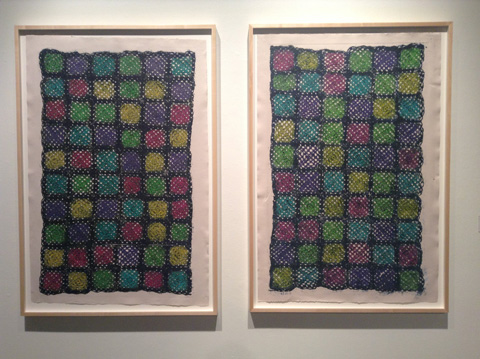
‘SECURITY BLANKET — (GRANNY SQUARES AFGHAN)’ Etching and relief ink on paper, 80 by 60 inches, 2013, by Peter Simensky. |
When displaying art less is generally more. If a few pieces make the point, why repeat it? If artworks need breathing room, and most do, why crowd them? But there’s also borderline emptiness; the Institute of Contemporary Art’s 2013 Maine College of Art Faculty Exhibition just barely feels suitably occupied.
ICA’s cavernous galleries are now dotted with pieces by current faculty members Sascha Braunig (painting), Samantha Haedrich (graphic design), Hilary Irons (foundation), and Peter Simensky (MFA), which, thanks to their strength, not their scale, can hold their own in the ample space around them. Like the Portland Museum of Art’s Biennial, this year’s MECA faculty show was not selected by outside jurors but chosen by an insider, ICA director Daniel Fuller, and makes another good argument for thoughtful curation instead of jurying.
Picking up on shared sensibilities and preoccupations, the contributions by Braunig, Haedrich, Irons, and Simensky subtly cohere. There is a sweetness to the attention being paid to the quotidian and diurnal; a historicism that does not emulate or idolize, but is more personal and endearing than that. It may explain the absence of strikingly new revelations, yet well-crafted execution and thought-provoking complexity alone supply plenty of gratification and interest.
Braunig’s paintings and sculptures present a curious retro approach. Northern Renaissance portrait conventions coalesce with Art Deco style, a material approximation of Play-Doh, and a quaintly uncomplicated feminism. The dimensional aspect of Braunig’s abstract and figurative paintings is created through form-defining patterning and laboratorial illumination, which push the imagery past the point of illusion into disappearance. It is a sly comment on how the desire or demand to disappear plays out on the social interfaces of skin and fashion.
Haedrich’s Records is a grid of index cards noting the artist’s activities during three months of this year. Among the information listed are commodities bought, hours slept, food consumed, as well as social events and excursions. The visual and, by extension, habitual monotony is only occasionally interrupted by a crossword puzzle or image. The whole thing feels unfair. All experience is treated the same. All appears divulged, yet nothing revealed. Although there is no explicit reference to Facebook and its dishearteningly uniform posts, similarities are obvious. One can only hope that meaningful experience still occurs in the interstices, outside of social media.
Irons’s paintings are near-ekphrastic, not literally describing but evoking the atmosphere and space of Anton Chekhov’s 1886 short story “Easter Night.” Each work’s timeless landscape setting is confidently painted in a pale palette and disrupted, in the artist’s trademark style, by abstract forms, figurative elements, and perspectival framing devices (inspired by a cable ferry in the story). These displacements function like distancing question marks addressing the construction of representation, particularly that of nature, whether in words or images.
Simensky’s collagraphic prints of afghan blankets and large chalk rods leaning against the walls like a giant child’s idea of a minimalist sculpture share labor-intensity and media-crossing translation with work in the PMA Biennial. Using domestic textiles as printing matrixes is not new, but Simensky’s prints are remarkable for their painstakingly faithful execution and powerful illusionism, fueled by tactile embossing and intricate reversals as ink pools where the crocheted original recedes. Attention this close to texture and color of these homey and homely items suggests the kind of magical thinking that is a hallmark of object-oriented ontology, which supposes that objects possess feelings, volition, and the ability to communicate.